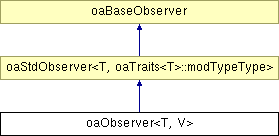 |
 |
 |
||||||
Inheritance diagram for oaObserver<T, V>:

 |
Public Methods | |
| oaObserver (oaUInt4 priorityIn, oaBoolean enabledIn=true) | |
| virtual | ~oaObserver () |
| virtual void | onBeginCreate (oaObject *owner, oaUInt4 scopeID) |
| virtual void | onEndCreate (T *object, oaUInt4 scopeID) |
| virtual void | onBeginDestroy (T *object, oaUInt4 scopeID) |
| virtual void | onEndDestroy (oaObject *owner, oaUInt4 scopeID) |
Static Public Methods | |
| oaBoolean | hasObservers () |
Note: The V template argument allows only the constant as defined by oaRevisionTraits<T>::scopedObserverRevision.
For example, consider an oaNet::destroy operation. This operation can be considered hierarchical in that a higher level call results in several side effects:
An application can use the onBeginDestroy and onEndDestroy scoped observer notifications to monitor the entire range of the destroy operation.
Authors of plug-ins that use the OpenAccess change management system to synchronize design changes from multiple processes use scoped observers to group information about hierarchical design changes.
For more information about scoped observers, refer to Scoped Observer Notifications in the OpenAccess Observers section of the Programmers Guide.
|
||||||||||||||||
|
This is the constructor for scoped observers. |
|
|||||||||
|
This is the destructor for scoped observers. |
|
|||||||||
|
Returns a boolean indicating whether or not this object has scoped observers. Reimplemented from oaStdObserver<T, oaTraits<T>::modTypeType>. |
|
||||||||||||||||
|
This function is called when the creation sequence for an object begins. It marks the beginning of a set of scoped changes. Refer to Scoped Observer Notifications in the OpenAccess Observers section of the Programmers Guide for more information.
|
|
||||||||||||||||
|
This function is called when the destruction sequence for an object begins. It marks the beginning of a set of scoped changes. Refer to Scoped Observer Notifications in the OpenAccess Observers section of the Programmers Guide for more information.
|
|
||||||||||||||||
|
This function is called when the creation sequence for an object ends. It marks the end of a set of scoped changes. Refer to Scoped Observer Notifications in the OpenAccess Observers section of the Programmers Guide for more information.
|
|
||||||||||||||||
|
This function is called when the destruction sequence for an object ends. It marks the end of a set of scoped changes. Refer to Scoped Observer Notifications in the OpenAccess Observers section of the Programmers Guide for more information.
|

Copyright © 2002 - 2010 Cadence Design Systems, Inc.
All Rights Reserved.